Master Cisco 300-415 Exam with Reliable Practice Questions
Which TLOC color is used for site-to-site communication in a Google Cloud integration with Cisco SD-WAN?
Correct : A
In Cisco SD-WAN, TLOC (Transport Locator) colors are used to categorize and manage different types of transport networks. When integrating with cloud services such as Google Cloud, specific TLOC colors are designated for managing site-to-site communication within the cloud infrastructure.
1.TLOC Color Assignment:
oFor Google Cloud integration, Cisco SD-WAN uses specific TLOC colors to differentiate between various types of transport links and to ensure that traffic is routed appropriately between sites.
1.Private1 for Site-to-Site Communication:
oThe TLOC color private1 is specifically used for site-to-site communication within Google Cloud. This ensures that the traffic between different sites within the Google Cloud infrastructure is managed efficiently and securely.
1.Reference:
oCisco SD-WAN Cloud Integration Guide
oCisco SD-WAN Google Cloud Configuration Documentation
Start a Discussions
Which data policy configuration influences BGP routing traffic flow from LAN to WAN?
A)
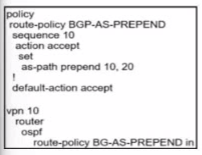
B)
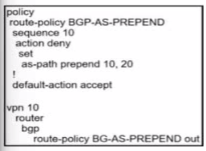
C)
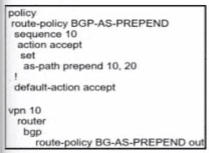
D)
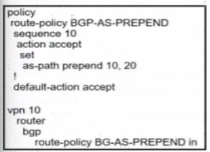
Correct : C
In Cisco SD-WAN, data policies can influence the routing traffic flow, particularly when using BGP (Border Gateway Protocol) to manage the traffic from the LAN to the WAN. This involves route manipulation techniques such as AS-path prepending to influence path selection.
1.AS-Path Prepending:
oAS-path prepending is a technique used to manipulate the path selection process in BGP. By adding extra AS numbers to the AS-path attribute, you make a particular route less preferred.
oThis can be useful in directing traffic to take a different path by making certain routes appear longer.
1.Option C Analysis:
oPolicy Definition: The policy named BGP-AS-PREPEND includes a sequence that sets the AS-path to prepend the AS numbers 10 and 20.
oApplication: The policy is applied in the outbound direction of BGP, which means it will influence the BGP routes being advertised from the LAN to the WAN.
oThis ensures that the traffic flow from the LAN to the WAN is influenced by the AS-path prepending, making certain paths less preferred.
1.Reference:
oCisco SD-WAN Routing Configuration Guide
oCisco SD-WAN BGP Policy Configuration Documentation
Start a Discussions
Customer has two branch silos with overlapping IPs How must the data policy be configured to establish communication between the sites and server to avoid overlapping?
A)
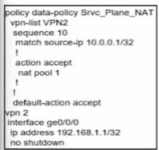
B)
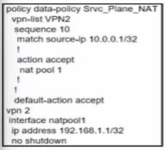
C)
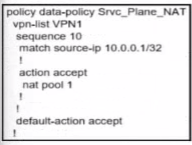
D)
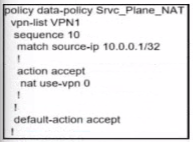
Correct : A
When dealing with overlapping IP addresses in different branch sites, it's crucial to use NAT (Network Address Translation) to avoid IP conflicts and establish proper communication.
1.NAT Configuration:
oSource NAT: This involves translating the source IP addresses of the packets as they leave a specific interface. This can help avoid IP conflicts by ensuring that the IP addresses used within the network are unique.
oData Policy: A data policy must be created that matches the source IP addresses and applies the NAT pool to translate these addresses.
1.Option A Analysis:
oPolicy Definition: The data policy Srvc_Plane_NAT includes a sequence that matches the source IP 10.0.0.1/32 and accepts the action to apply NAT using nat pool 1.
oInterface Configuration: The interface ge0/0/0 is configured with the IP address 192.168.1.1/32 and is not shut down, ensuring it is active and can handle the NAT translation.
1.Reference:
oCisco SD-WAN NAT Configuration Guide
Start a Discussions
Which two architectural components are part of an SD-WAN high availability vManage cluster? (Choose two.)
Correct : D, E
In a Cisco SD-WAN high availability (HA) vManage cluster, several components work together to ensure redundancy and availability. The vManage cluster is responsible for network management and configuration and consists of multiple servers that handle different functions.
1.Application Server: This server handles the core functionalities of vManage, including processing user requests, managing configurations, and executing policies. In an HA setup, multiple application servers work together to provide redundancy and load balancing.
1.Messaging Server: The messaging server is responsible for inter-server communication within the cluster. It ensures that configuration changes, policy updates, and other important messages are propagated across all vManage servers in the cluster.
These components work in tandem to maintain the operational integrity and availability of the vManage system in an HA configuration.
3.Reference:
oCisco SD-WAN vManage Cluster Deployment Guide
oCisco SD-WAN High Availability Configuration Documentation
Start a Discussions
Exhibit.
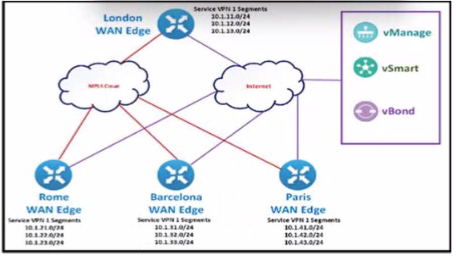
The SD-WAN network is configured with a default full-mash topology. An engineer wants Barcelona and Paris to communicate to each other through the London site using a control Which control policy configuration accomplishes the task?
A)

B)

C)

D)

Correct : A
To achieve communication between Barcelona and Paris through the London site, a control policy needs to be configured to force traffic from these two sites to pass through the London site. This setup involves manipulating the routing information such that London becomes a transit hub for traffic between Barcelona and Paris.
1.Understanding the Policy Requirements:
oCentralized Policy: This type of policy is applied at the controller level and affects multiple devices in the SD-WAN fabric. It allows the control of routing behavior across the entire network.
oRoute Policy: Specifically, a route policy will be used to set the preferred path for traffic between sites, ensuring that it passes through London.
1.Option Analysis:
oOption A: Shows the configuration of a centralized policy with a focus on route policy, which is necessary to achieve the desired traffic flow manipulation.
oOther Options: Do not provide the necessary centralized policy or route policy configurations that are needed to control the routing paths between the sites.
1.Configuration Details:
oCentralized Policy: Define the policy under the centralized policy section in the vManage GUI.
oRoute Policy: Create and apply a route policy that specifies the desired routing behavior for traffic between Barcelona and Paris, ensuring it routes through London.
1.Reference:
oCisco SD-WAN Control Policy Configuration Guide
Cisco SD-WAN Centralized Policy Documentation
Start a Discussions